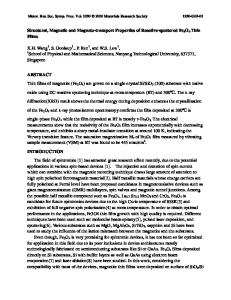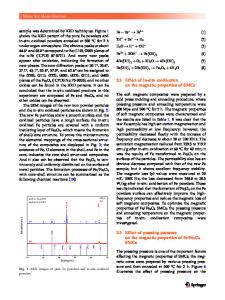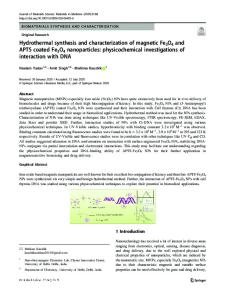Magnetic Properties of Epitaxial Mbe-Grown thin Fe 3 O 4 Films on MgO (100)
- PDF / 1,228,649 Bytes
- 6 Pages / 414.72 x 648 pts Page_size
- 7 Downloads / 310 Views
Figure 1: RHEED patterns of MgO(100) (a) and Fe3 04(100) (b) at room temperature, with the e-beam parallel to the [100] direction. the e-gun evaporation fluxes are controlled by a cross-beam quadrupole mass-spectrometer feedback system. For further details on the preparation, see [1]. Two types of samples have been grown; samples with the Fe3O 4 layer uniform in thickness and samples in which the Fe 3O4 layer was deposited in the form of a wedge (from 0 to 400 A) by slowly withdrawing a shutter located close to the substrate. All samples were characterized in-situ with RHEED. Fig. 1 shows typical RHEED patterns of the MgO (a) and the Fe3 0 4 (b) surface at room temperature. From the photos it can be concluded that the Fe4O 4 grows epitaxially on the MgO substrate without indications of island growth. It also appears that the MgO substrate was flat on an atomic scale, because of the clear presence of Kikuchi lines. These lines persist when depositing Fe3 0 4 , indicating that the roughness does not increase significantly with Fe3O4 growth. Upon deposition of Fe3 O4 and after cooling down, the observed lattice constant doubles, as follows from the appearance of additional streaks located between the MgO [0,0] and [-1,0] and [1,0] streaks. This is what one expects since the unit lattice cell length of Fe3 0 4 is about twice that of MgO; (8.396 and 4.2117 A, respectively). A more detailed analysis of the growth will be given in [4]. The magnetic characterization of the wedge sample has been performed by means of the magneto-optic Kerr effect (MOKE) at room temperature. The MOKE studies are performed in the longitudinal geometry. The longitudinal MOKE experiments are performed with the applied field oriented along two different axes in the plane of the film, namely the [100] and [110] axes. Below thicknesses of 50 A Fe3 O 4 , the signal intensity is too low to measure hysteresis loops. A uniform 300 A thick Fe3O 4 film has been investigated by means of SQUID (Quantum Design MPMS5) and FMR, employing a standard commercial FMR spectrometer with a Bruker X-band cavity (9.79 GHz) and a flow cryostat to obtain temperature dependent measurements in the range of 5 up to 300 K.
SQUID AND LONGITUDINAL MOKE EXPERIMENTS Typical longitudinal hysteresis loops with the field applied along the in-plane [110] and [100] directions are shown in Fig. 2. The in-plane hysteresis loops reveal a low coercive field, 28
0.150
c 0.075 _
0
0.000
D.---0.075
-0.150
emu
H//[110] I
-20
,
I ,
-10
0
I
10
H H [100]
,.
I
20
I
-10
-20
I
,
0
10
.
I
20
H (kA/m) Figure 2: Hysteresis loops for 340 A Fe3 04(100) measured by longitudinal MOKE with the field applied parallel to the film plane along the [110] (a) and [100] (b) axes. indicating the soft magnetic behavior of magnetite and show low saturation fields, indicating that the magnetization is oriented preferentially along the film plane rather than perpendicular to it. The in-plane hysteresis loop with the field applied along [110] shows a 100 % remanence, whereas with the
Data Loading...











